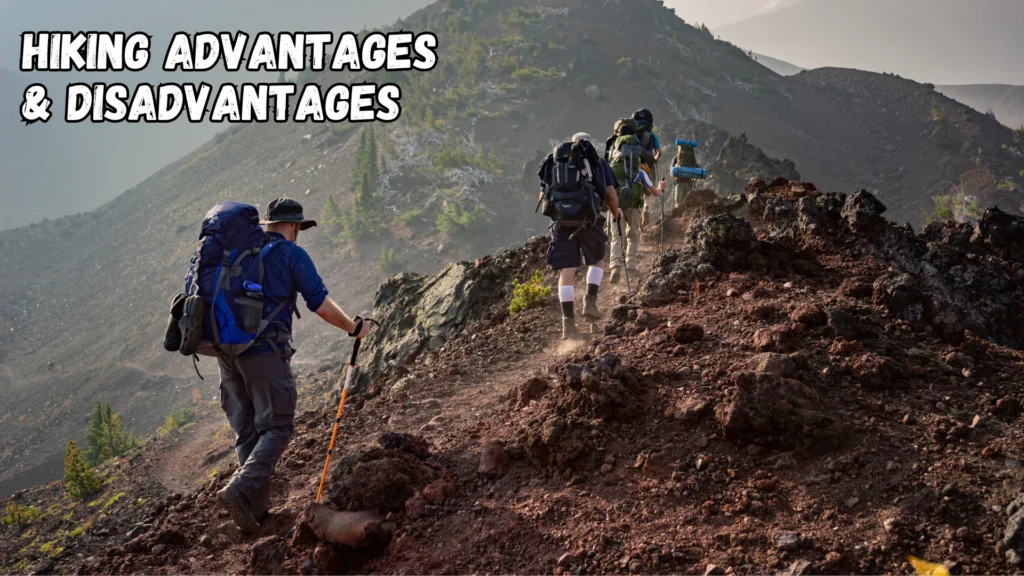Thru hiking the Pacific Crest Trail is an adventurous journey that spans over 2,600 miles, encompassing the West Coast of the United States. It requires careful planning, physical endurance, and mental preparation for the challenges ahead.
Whether you’re a seasoned hiker or a novice, this quick guide will help you navigate the trail, from essential gear to resupply strategies, while immersing yourself in the stunning landscapes along the way. So, gear up, lace your boots, and embark on an unforgettable adventure through the Pacific Crest Trail’s diverse terrains and breathtaking vistas.
Preparation
Preparing for a Thru Hike on the Pacific Crest Trail (PCT) requires thorough preparation on multiple fronts.
Physical Training
- Build endurance through regular walking and hiking.
- Strength training for the legs, core, and back muscles is essential.
- Cardio exercises like running and cycling can improve stamina.
Mental Preparation
- Develop mental resilience to face challenges on the trail.
- Practice mindfulness and meditation for peace and focus.
- Set realistic expectations and a positive mindset for the journey.
Logistics
- Plan gear and food resupply points along the trail.
- Ensure permits, maps, and guidebooks are organized and accessible.
- Arrange transportation to and from the trailheads.
Credit: www.sawyer.com
Gear And Equipment
Discover essential gear and equipment for a successful thru-hike on the Pacific Crest Trail. Get expert advice and find out what you need to pack for this epic adventure.
Gear and Equipment When preparing for a thru-hike on the Pacific Crest Trail, having the right gear and equipment is essential for a successful journey. From selecting the proper footwear to deciding between ultralight and traditional gear, each choice plays a crucial role in your overall experience.
Essential Gear
Pack smart by bringing essential items like a lightweight tent, sleeping bag, and a quality backpack. Don’t forget to include a reliable water filtration system and durable cookware for meal prep.
Ultralight Vs. Traditional Gear
Opt for ultralight gear if you prioritize weight reduction, but traditional gear offers more comfort and durability. Consider your hiking style and preferences when making this decision.
Choosing The Right Footwear
Select footwear that provides good support and traction. Trail runners are lightweight and breathable, while hiking boots offer ankle stability. Test different options to find what works best for you.
Navigating The Trail
When thru-hiking the Pacific Crest Trail, one of the most crucial aspects is navigating the trail. Understanding trail markers, utilizing maps and GPS, and locating water sources are essential for a successful trek. Here’s a quick guide to help you navigate the trail with ease.
Understanding Trail Markers
Trail markers are key to staying on the right path. Look for familiar symbols like blazes on trees, cairns, or mileage signs. Always follow these markers closely to avoid getting lost.
Using Maps And GPS
Carrying a detailed map is a must for thru-hikers. Use GPS devices or smartphone apps like Guthook’s Pacific Crest Trail Guide to track your progress and pinpoint your location accurately.
Navigating Water Sources
Knowing where to find water along the trail is essential. Consult guidebooks and trail resources to identify reliable water sources. It’s crucial to plan your route around these points to stay hydrated throughout your hike.
Resupplying And Food
One of the most crucial aspects of thru-hiking the Pacific Crest Trail is resupplying and ensuring you have enough food to sustain you throughout the journey. This section will provide you with valuable strategies for resupplying, tips for meal planning, and guidance on dealing with wildlife.
Strategies For Resupplying
When thru-hiking the Pacific Crest Trail, proper resupplying is essential to keep yourself fueled and energized. Here are a few effective strategies to consider:
- Plan your resupply points in advance, considering the distance between each stop and the availability of stores or post offices.
- Send yourself mail drops containing food, supplies, and any required gear, which can be picked up at designated points along the trail.
- Utilize resupply services provided by local businesses or organizations, who can arrange for packages to be waiting for you at specific locations.
- Consider purchasing food and supplies from nearby towns or villages along the trail, resupplying as you go.
- Take advantage of hiker boxes, where hikers can leave behind unneeded food and gear for others to use and pick up.
Meal Planning
Meal planning is crucial for maintaining energy levels and avoiding nutritional deficiencies. Here are a few tips to help you plan your meals effectively:
- Create a meal plan that includes a good balance of macronutrients: carbohydrates, proteins, and fats.
- Opt for lightweight and calorie-dense food options like energy bars, nuts, dried fruits, and dehydrated meals.
- Consider your dietary preferences and restrictions, ensuring you have enough options that meet your needs.
- Pre-package meals in individual portions to save space and make mealtime preparation more convenient.
- Include a variety of food options to prevent taste fatigue, incorporating both sweet and savory choices.
Dealing With Wildlife
Encountering wildlife is one of the remarkable experiences of thru-hiking the Pacific Crest Trail. Here are a few precautions and guidelines to follow:
- Store your food in bear-resistant containers to avoid attracting bears and other wildlife.
- Hang your food from bear poles or trees to keep it out of reach of animals.
- Be aware of the local wildlife in each area you pass through and respect their natural habitat.
- Refrain from feeding or approaching wildlife, ensuring you maintain a safe distance at all times.
- Carry bear spray or other deterrents for protection, especially in areas known for a high bear population.
Physical And Mental Challenges
Thru hiking the Pacific Crest Trail presents both physical and mental challenges, requiring endurance and resilience throughout the journey. This quick guide provides essential tips for successfully tackling this iconic trail.
In the challenging world of thru-hiking, the physical and mental obstacles of traversing the Pacific Crest Trail are significant.
Dealing With Altitude
Preparation for high altitudes is crucial to avoid altitude sickness. – Stay hydrated and pace yourself – Gradually ascend to acclimatize – Recognize symptoms and act promptly
Coping With Solitude
Combat feelings of isolation along the trail. – Connect with fellow hikers – Carry items for comfort and entertainment – Practice mindfulness and self-reflection
Avoiding Burnout
Prevent exhaustion during the long journey. – Take rest days to recuperate – Listen to your body’s signals – Mix up your routine for variety
Credit: www.reddit.com
Safety And Emergency Preparedness
When embarking on a thru-hike of the Pacific Crest Trail, safety and emergency preparedness are paramount. Being equipped to handle potential risks and emergencies in the wilderness is crucial for a successful and safe journey. In this guide, we will delve into essential aspects of safety and emergency preparedness for thru-hiking the Pacific Crest Trail
Wilderness First Aid
Wilderness first aid is a vital skill for thru-hikers. Understanding how to administer aid in remote locations can be lifesaving. It’s important to carry a comprehensive first aid kit and have knowledge of treating common trail injuries such as blisters, sprains, and cuts.
Understanding Natural Hazards
Before embarking on the Pacific Crest Trail, it’s crucial to understand the natural hazards that hikers may encounter. This includes familiarizing yourself with potential dangers such as landslides, avalanches, wildlife encounters, and extreme weather conditions. Being aware of these hazards and knowing how to mitigate the associated risks is essential for a safe hike.
Communicating In The Backcountry
Effective communication is imperative in the backcountry. Whether it’s coordinating with hiking partners or seeking help in an emergency, having reliable communication methods can be a lifeline. Carrying a satellite communication device or a Personal Locator Beacon (PLB) can ensure that you can reach out for help when needed.
Utilizing these safety measures and being prepared for emergencies will enhance your overall experience on the Pacific Crest Trail and provide peace of mind as you journey through the breathtaking wilderness.
Completing The Trail
As you near the completion of the Pacific Crest Trail, there are key elements to consider to ensure a successful finish. Celebrating Milestones, deploying Mental Strategies for the Final Stretch, and preparing for Life After Thru Hiking are crucial aspects.
Celebrating Milestones
- Recognize physical and mental achievements along the way.
- Take photos at iconic landmarks to commemorate your journey.
- Share stories with fellow hikers to create lasting memories.
Mental Strategies For The Final Stretch
- Stay focused on your goal of completing the trail.
- Break down the remaining miles into smaller, manageable segments.
- Practice mindfulness to stay present and motivated.
Life After Thru Hiking
Adjusting to life post-hike can present challenges. Consider joining hiking groups, setting new fitness goals, or planning your next adventure to maintain the trail’s spirit.
The Pacific Crest Trail offers a life-changing adventure for outdoor enthusiasts. With its stunning scenery and challenging terrain, thru-hiking the trail is a remarkable experience. By following the tips and advice in this guide, you can successfully plan and embark on this epic journey.
Happy hiking!
FAQs:
Can You Hike The PCT As A Beginner?
Yes, beginners can hike the PCT with proper preparation and training. Starting with shorter hikes can help build endurance and skills. It’s important to research, plan, and invest in quality gear. Additionally, consulting experienced hikers or guides can provide valuable insights for a successful journey on the PCT.
What Is The Best Guide For Hiking Pct?
The best guide for hiking the PCT is “The Pacific Crest Trail: Exploring America’s Wilderness Trail” by Mark Larabee and Barney Scout Mann. It provides detailed information on planning, route guidance, gear advice, and trail etiquette for a successful thru-hike experience.
How Long Does It Take To Thru-hike The Pct?
Thru-hiking the PCT typically takes 4 to 6 months based on around 20 miles per day.
What Is The Hardest Part Of The Pacific Crest Trail?
The hardest part of the Pacific Crest Trail is subjective, but many hikers find the Sierras challenging due to high altitude, unpredictable weather, and difficult river crossings.



